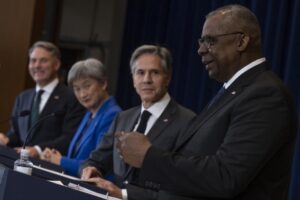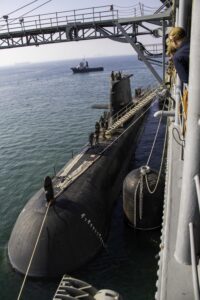Secretary of Defense Lloyd Austin on Tuesday committed to help Australia not have a capability gap between the retirement of the current Collins-class attack submarines and the future nuclear-powered AUKUS agreement submarines.
We dedicated 18 months for a period of consultation, and during that period our goal is to design the optimal pathway for Australia to get a nuclear-powered, conventionally armed submarine as quickly as possible. We recognize where Australia is and how – when its capability begins to diminish, and, of course, we will address all of that in that pathway that we create. And so, we will not allow Australia to have a capability gap going forward,” Austin said at a press conference annual conference between the U.S. and Australian defense and foreign ministers.

Over a year ago, U.S. Australian, and U.K. officials announced the AUKUS partnership to help Australia procure a new class of nuclear-powered attack submarines to ultimately replace the current six submarine fleet of conventionally-powered diesel-electric Collins-class vessels.
This initial 18-month period aims to help inform the Australian government on how to proceed.
“We really appreciate those comments. I mean, what has been underpinning the conversation that we have been having in – under the AUKUS framework is to look at, if there are capability gaps, how we make sure we plug them so in effect there are none,” Australian Defense Minister Richard Marles said during the Dec. 6 press conference,
While Austin did not elaborate on what he meant, in October, Rep Rob Wittman (R-Va.), ranking member of the House Armed Services subcommittee on seapower and projection forces, argued for one approach to help bridge the gap.
Wittman said the countries could have a joint deployment agreement using Australian submariners to crew a U.S. Virginia-class attack submarine with Australian and U.S. commanders on board in the Australian area of operations, but jointly operated by both countries (Defense Daily, Oct. 10).
Last year, Naval Operations Adm. Mike Gilday said it could take decades before an AUKUS nuclear-powered submarine is deployed in the water (Defense Daily, Sept. 23, 2021).
In July, Marles said the government intends to announce its choice of vessel in the first quarter of 2023, noting the plan would detail how they plan to deal with capability gaps after the Collins-class is due to be retired by before the AUKUS vessels come online. He noted extending the Collins-class would be part of the plan (Defense Daily, July 15).
“We’ll be talking about when that submarine will be in the water and to the extent that there is any capability gap that arises as a result of that timeframe – what is the solution then to plug in that gap,” he said at the time.
During the ministerial meeting press conference this week, Marles said that “we are really confident that the work that has been undertaken, which has been extensive, is on track and we’ll be in a position to make those announcements.”

Austin also said the two countries agreed to invite Japan to integrate into the new force posture initiatives the U.S. is creating with Australia, given increased tensions with China in the Indo-Pacific region.
Marles noted he and Australian foreign minister Penny Wong are due to visit Japan later this week to discuss that increased involvement.
“It is a great outcome of today’s meeting that we can go to Japan at the end of this week with an invitation for Japan to be participating in more exercises with Australia and the United States,” Marles said.
Marles also underscored the importance of continuing to integrate the U.S. and Australian defense industrial bases, spurred on by AUKUS.
“We need to be working closer together to enhance our military capability and to develop new technologies. But for all of that to happen, it’s really important that we do everything we can to break down barriers which exist in regulation between our two countries. And we couldn’t be more pleased in the sense of shared commitment that there has been on the part of both the U.S. and ourselves, in relation to making real steps forward in terms of breaking down those barriers to create that seamless defense industry environment.”
Marles said he visited General Dynamics’ Electric Boat [GD] facility in Quonset Point, R.I., on Monday “and saw just something of the size of the endeavor involved in building nuclear-powered submarines.”
However, he reiterated the importance to Australia that the AUKUS submarines’ production capability is developed in Australia, noting Australia built the Collins-class in Adelaide.
Separately, the ministers reaffirmed the U.S. intends to continue the rotational presence of military capabilities to Australia including bomber task force rotations, fighters, and add other Navy and Army rotations in the future.